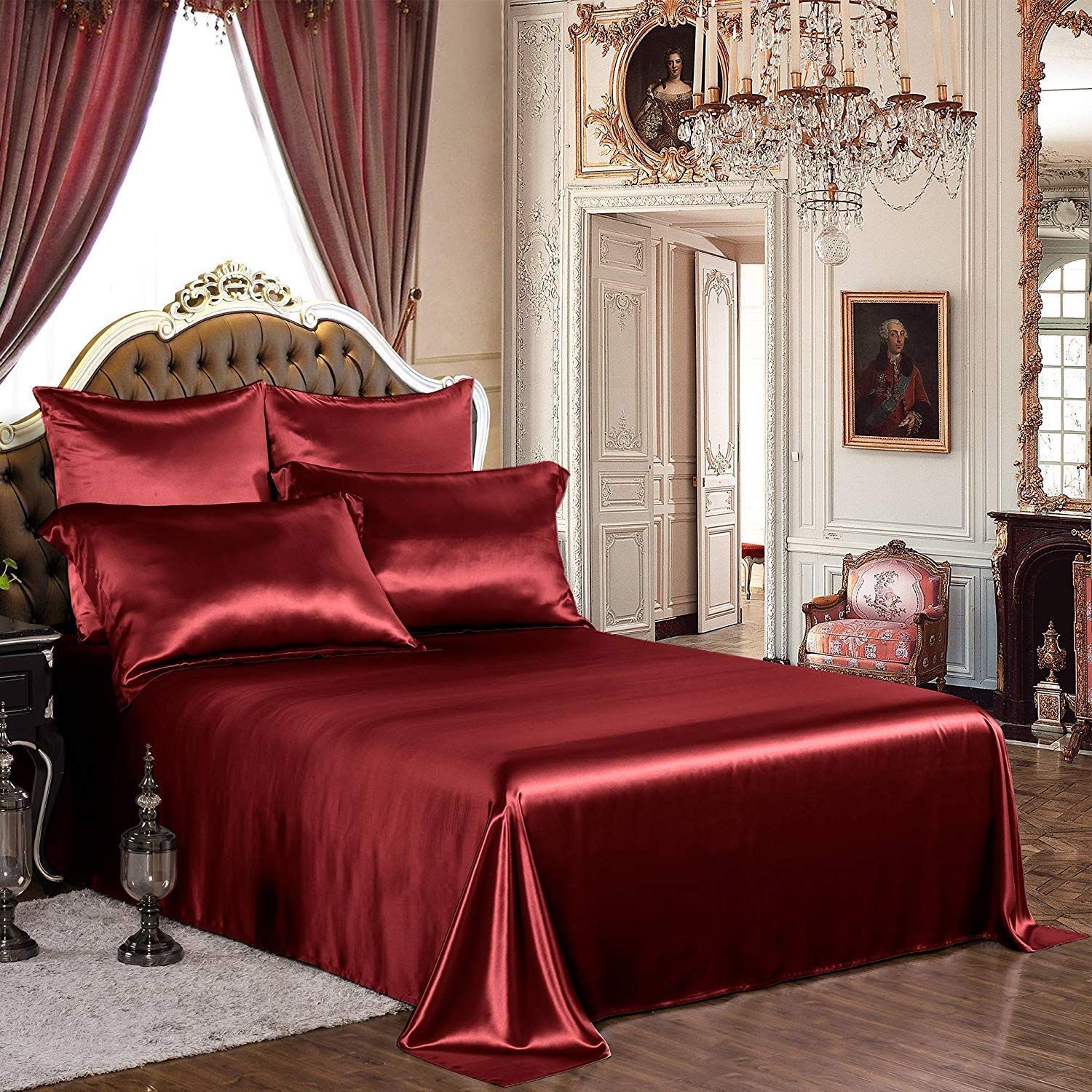Step into a realm where dreams are woven in silk. Discover the world of luxurious silk bed sets, a haven of comfort and elegance. In this comprehensive guide, we unravel the secrets to a slumber that is truly extraordinary. From the silken touch to the health benefits, we explore every aspect of silk bedding, empowering you to create a sleep sanctuary that is second to none.
Why Choose Silk Bedding?
Okay, let’s talk about feeling pampered. We’re talking about sinking into a bed that feels like a dream – that’s what a silk bed set promises. Imagine the smooth, cool sensation of real silk against your skin, and how it seems to almost magically keep you at just the right temperature all night long. A silk bed set is an investment in amazing sleep, and honestly, in feeling a little luxurious every single day.
The Science of Silk: What Makes it So Special?
Here’s the thing about silk – it’s not just about the luxurious feel. Silk bed sets are made from incredible natural fibers, woven so finely they create this incredibly soft and shiny fabric. Seriously, a silk bed set can make your bedroom look like a magazine shoot! But let’s talk about why silk is so special for bedding:
- Temperature Regulation: Silk is like a natural thermostat – it helps you stay cool when it’s hot and warm when it’s chilly. No more waking up sweaty or freezing! This is because silk is a breathable fabric that allows air to circulate, preventing heat from getting trapped.
- Moisture-Wicking: Silk naturally wicks away moisture, so it’s perfect if you tend to get a little warm at night. You’ll wake up feeling dry and comfy.
- Gentle on Skin: If you have sensitive skin or allergies, silk is a total game-changer. It’s naturally hypoallergenic, which means it’s less likely to irritate your skin. Some people even find that silk can help reduce the appearance of wrinkles.
- Potential Anti-Aging Benefits: Okay, this might sound unbelievable, but the amino acids in silk are similar to those in our skin. Some experts believe that sleeping on silk can actually help your skin stay smooth and youthful. While more research is needed, it’s an intriguing possibility!
Finding the Perfect Silk Bed Set: A Buyer’s Guide
Ready to take the plunge? Here’s what to consider when you’re shopping for a silk bed set:
Momme Weight: You’ll see this term a lot. Basically, “momme” (pronounced “moe-mee”) tells you the weight of the silk, which is an indicator of its thickness and durability. Higher momme weight usually means a heavier, more luxurious feel and a longer lifespan for your sheets.
Silk Grade: Silk is graded on its quality, taking into account factors such as smoothness, evenness of weave, and overall purity. The higher the grade, the better the quality. Look for grades like 6A or higher for exceptional silk.
Types of Silk: Yes, there are different kinds of silk! Mulberry silk, produced by silkworms that feed exclusively on mulberry leaves, is considered the highest quality due to its smooth texture and lustrous sheen. You’ll also find Tussah silk, known for its slightly more textured feel, and Charmeuse, prized for its luxurious drape and sheen.
To upgrade your sleep set-up, consider these luxurious silk bedsheets, which will make you feel as if you’re sleeping on a cloud. For a king-sized bed, find silk sheets in various colors and patterns to match your bedroom décor.
Caring for Your Silk: Tips for Long-Lasting Luxury
Silk is a natural fiber, so it needs a little TLC. But don’t worry, it’s not as high-maintenance as you might think. Here’s how to keep your silk bed set looking and feeling amazing for years:
- Gentle Washing: Hand washing is the gentlest method for cleaning silk, using lukewarm water and a pH-neutral detergent specifically designed for delicate fabrics. If you must use a washing machine, select a delicate cycle with cold water and place your silk items inside a mesh laundry bag for added protection.
- Air-Drying is Best: Avoid harsh sunlight or heat when drying your silk. Hang it to air dry in a well-ventilated area, away from direct sunlight or heat sources.
- Ironing with Care: If you must iron your silk, use the lowest heat setting on your iron (the “silk” setting if available) and a pressing cloth to prevent any water spotting or damage to the delicate fibers.
Beyond the Bedroom: Silk for Every Aspect of Your Life
Once you experience the magic of silk, you’ll want it everywhere! Silk pillowcases are said to be amazing for your hair and skin. They create less friction, which can help prevent hair breakage and frizz while potentially minimizing sleep wrinkles. A silk eye mask can make you feel like you’re at a spa, blocking out light and promoting relaxation.
Is Silk Bedding Right for You? Weighing the Pros and Cons
So, you’re thinking about treating yourself to some luxurious silk sheets? It’s easy to see the appeal – who wouldn’t want to drift off to dreamland enveloped in that smooth, luxurious fabric? But before you take the plunge, let’s weigh the pros and cons to see if silk bedding is really the right fit for you.
Pros of Silk Bedding:
- Unparalleled Comfort: Silk is renowned for its exceptional softness and smooth texture, providing a luxurious sleep experience.
- Temperature Regulation: Silk’s natural breathability helps regulate temperature, keeping you cool in summer and warm in winter.
- Skin and Hair Benefits: The smooth surface of silk minimizes friction, potentially reducing hair breakage, frizz, and sleep wrinkles.
- Hypoallergenic: Silk is naturally resistant to dust mites, mold, and mildew, making it a great option for allergy sufferers.
- Long-Lasting: High-quality silk, when cared for properly, can last for many years, making it a worthwhile investment.
Cons of Silk Bedding:
- Price: Silk bedding is a significant investment compared to other materials like cotton, linen, or bamboo.
- Delicate Care: Silk requires delicate care, typically hand-washing or dry cleaning, which can be time-consuming for some.
- Slippery Feel: While loved by many, silk’s slippery feel can take some getting used to and may not be ideal for everyone.
- Potential for Staining: Silk is more prone to staining than some other fabrics, so spills should be addressed promptly.
Silk vs. Satin: Decoding the Differences
Okay, so you’re trying to decide between satin and silk sheets, and you want to know which one reigns supreme. It’s a common question, especially when you’re looking for that extra touch of luxury for your sleep haven. Both fabrics have a reputation for being smooth and inviting, but there are some key differences to keep in mind.
Satin: Think of satin as the versatile friend in the fabric world. Satin is a weaving technique, not a material itself. You can find satin made from silk, polyester, nylon, and even blends. This weaving technique creates that signature glossy surface and a luxurious feel, especially on those warmer nights. And here’s a bonus: satin sheets tend to be more budget-friendly compared to their pure silk counterparts.
Silk: Now, silk, on the other hand, is in a league of its own. This natural fiber, spun by silkworms, has long been synonymous with luxury and indulgence. People rave about its exceptional softness, breathability, and almost magical ability to regulate temperature. Plus, silk’s hypoallergenic properties might make it a dream come true for those with sensitive skin or allergies. However, all this luxury comes at a price, quite literally. Silk sheets tend to be a more expensive investment, and they require a gentler touch when it comes to washing and care.
The Verdict:
So, back to the big question: satin or silk? There’s no one-size-fits-all answer. It boils down to what you’re looking for in your bedding.
Choose silk if:
- You prioritize breathability, temperature regulation, and hypoallergenic qualities.
- You don’t mind investing a bit more for exceptional quality.
- You’re willing to commit to the gentle care that silk requires.
Choose satin if:
- Budget is a major consideration.
- You prefer a fabric that’s a bit easier to care for.
- You still want that luxurious, silky feel at a more approachable price point.
Ultimately, the best way to decide is to consider your sleep style, budget, and preferences.
The Downside of Silk: What to Know Before You Invest
Okay, so you’re hearing all this buzz about silk and how amazing it is. But let’s be real, nothing is perfect, right? Silk is no exception. Let’s shed light on some potential downsides so you can make a fully informed decision.
1. High Maintenance: Silk is a bit of a diva, honestly. It’s delicate and needs to be treated like royalty. We’re talking hand-washing or, if you’re feeling fancy, dry cleaning only. Forget tossing it in the washing machine with your other laundry – silk won’t stand for that kind of disrespect.
2. The Price Tag: Let’s face it, silk can be expensive. If you’re on a budget, the price alone might make you reconsider. However, keep in mind that high-quality silk can last for years with proper care, making it an investment in your sleep quality and well-being over the long term.
3. Potential for Allergies: While silk is often touted as hypoallergenic, some people might find that their skin throws a tantrum and breaks out in a rash. If you have particularly sensitive skin, it’s always a good idea to test a small area before committing to a full set of silk bedding.
4. The “Slippery” Factor: That luxurious, smooth texture? It can feel like sleeping on an ice rink for some. If you’re someone who tosses and turns a lot in your sleep, you might find that silk sheets are a little too slippery for your liking.
The Bottom Line:
Silk bedding has its perks, but it’s not for everyone. Consider the potential downsides carefully before investing in silk sheets.
Silk Bed Set FAQs: Your Questions Answered
Q: What is momme weight, and why does it matter?
A: Momme weight is a measure of silk’s weight and density. Higher momme weight (typically 19 or higher for bedding) indicates a denser, more durable fabric that will last longer.
Q: How do I wash silk bedding?
A: Hand-washing is best using a gentle detergent specifically formulated for delicate fabrics. You can also machine-wash on a delicate cycle with cold water, placing items in a mesh bag for protection. Avoid harsh detergents, bleach, and fabric softeners, which can damage silk fibers.
Q: Can silk bedding help with allergies?
A: Silk is naturally hypoallergenic and resistant to dust mites, which can be a trigger for allergies. While it’s not a guaranteed solution for everyone with allergies, many people find that silk bedding helps to reduce allergy symptoms.
Q: Is silk bedding worth the investment?
A: Whether silk bedding is worth the investment is a personal decision. If you prioritize luxury, comfort, temperature regulation, and the potential benefits for your skin and hair, and you’re willing to commit to its care, then silk could be a worthwhile investment.
Sweet Dreams Are Made of This: Choosing the Right Bedding for You
So there you have it – the lowdown on silk bed sets. It’s more than just a luxury; it’s an investment in better sleep, a touch of elegance in your bedroom, and maybe even a little self-care. Who wouldn’t want that?
- Kitchen Counter Corner Ideas: Style Your Awkward Angles Now - December 31, 2025
- Best Finish for Butcher Block Countertops: Choosing the Right Option - December 30, 2025
- Seal for butcher block: Find the best food-safe finish - December 29, 2025










